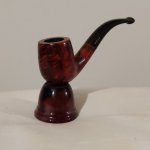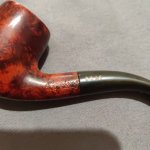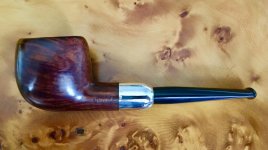Show Off Your Barlings Here
- Thread starter sablebrush52
- Start date
You are using an out of date browser. It may not display this or other websites correctly.
You should upgrade or use an alternative browser.
You should upgrade or use an alternative browser.
SmokingPipes.com Updates
Watch for Updates Twice a Week
@strongcity That looks like 1947 thru 1954, based on the kind of "BARLING'S MAKE stamp. Did you notice if there was a reg'D number on the underside of the stem? If there's a reg'D number then the pipe is no later than 1950. If it is stamped Barling DESIGN, then it's 1950 to about 1954-55.
The post 1954-55 pipes used a logo with a more pronounced arch on the word BARLING'S.
The post 1954-55 pipes used a logo with a more pronounced arch on the word BARLING'S.
Thanks for the information; nice to know these details. There is no reg'D on the underside of the stem.@strongcity That looks like 1947 thru 1954, based on the kind of "BARLING'S MAKE stamp. Did you notice if there was a reg'D number on the underside of the stem? If there's a reg'D number then the pipe is no later than 1950. If it is stamped Barling DESIGN, then it's 1950 to about 1954-55.
The post 1954-55 pipes used a logo with a more pronounced arch on the word BARLING'S.
Okay, so 1947 to 1955.Thanks for the information; nice to know these details. There is no reg'D on the underside of the stem.
I understand what you mean!This thread makes my heart go tapocketa-tapocketa...
And where might that be?
Please put your location in your Profile as people are forgetful.
Why:
That will save questions in the future as to where you live when you later mention local stores, weather, tobacco prices, availability, regulations, location of photos, wildfires, air quality, etc. In many instances that saves time for those who read your posts.
How:
Under your avatar, (top right, left most of three symbols) you choose "Account Details", which brings up "My Account". "My Location" is halfway down. Whatever you're comfortable with- town, city, county, state. Just country if you must.
Sorted, thanks.I understand what you mean!
And where might that be?
Please put your location in your Profile as people are forgetful.
Why:
That will save questions in the future as to where you live when you later mention local stores, weather, tobacco prices, availability, regulations, location of photos, wildfires, air quality, etc. In many instances that saves time for those who read your posts.
How:
Under your avatar, (top right, left most of three symbols) you choose "Account Details", which brings up "My Account". "My Location" is halfway down. Whatever you're comfortable with- town, city, county, state. Just country if you must.
Any Barling Experts out there? Ahahaha. I got a chuckle from the other day. (all eyes in room gaze to Sablebrush).
I just snagged these 2 for $75. That included overseas shipping. What!
I’ve interpreted some of your contributions to barlings that the “design” in the stem helps date the pipe (or stem for that matter). I’ll read over the various posts and articles again. It seams like every time I get a barling I reference the complete writing to reconnect with what little knowledge I’ve retained.
Is the straight grain stamping significant at all? Who would have said, stamp that one this way? I’ve read that charatan models were up for interpretation of the carver.
Here’s the links to the two pipes.


I just snagged these 2 for $75. That included overseas shipping. What!
I’ve interpreted some of your contributions to barlings that the “design” in the stem helps date the pipe (or stem for that matter). I’ll read over the various posts and articles again. It seams like every time I get a barling I reference the complete writing to reconnect with what little knowledge I’ve retained.
Is the straight grain stamping significant at all? Who would have said, stamp that one this way? I’ve read that charatan models were up for interpretation of the carver.
Here’s the links to the two pipes.

BARLINGS YCOLDEWOOD Straight Grain Briar Estate Pipe Used | eBay
Overall length; 12.7 cm.
www.ebay.com

BARLING 1593 Guinea Grain Straight Briar Estate Pipe Used | eBay
Overall length; 14.1 cm.
www.ebay.com
From what I see you got 2 family era pipes. They both are going to need a good bit of work. But they are very doable. You got a decent price. Jesse would be able to give you info on the straight grain. I have a idea. Post war. Definitely worth a restoration . Looks like you did well for the price
I think 1950ish. I was reading his input and one of the barling gents running the shop at charatan and was wondering if there is any connection in regards to the grain decisionsFrom what I see you got 2 family era pipes. They both are going to need a good bit of work. But they are very doable. You got a decent price. Jesse would be able to give you info on the straight grain. I have a idea. Post war. Definitely worth a restoration . Looks like you did well for the price
Wow! You potentially got two steal deals! The straightgrain was Barling's highest grading. You won't find a model number, since these weren't normal production. If it cleans up well, you may have a pipe worth about $300 on the market. One problem is the level of oxidation on the stem. It ma y take quite a bit of sanding down to get below teh affected material, and that would affect value. Period of manufacture is post war and I may be able to date it a little better once it's been cleaned up, with some good snaps, and some information about any nomenclature on the pipe and on the stem. If there's a Reg'D number on the underside of the stem, that will help me with dating. Barling pots are excellent smoking implements and this thick walled fellow is one of my favorite shapes.Any Barling Experts out there? Ahahaha. I got a chuckle from the other day. (all eyes in room gaze to Sablebrush).
I just snagged these 2 for $75. That included overseas shipping. What!
I’ve interpreted some of your contributions to barlings that the “design” in the stem helps date the pipe (or stem for that matter). I’ll read over the various posts and articles again. It seams like every time I get a barling I reference the complete writing to reconnect with what little knowledge I’ve retained.
Is the straight grain stamping significant at all? Who would have said, stamp that one this way? I’ve read that charatan models were up for interpretation of the carver.
Here’s the links to the two pipes.

BARLINGS YCOLDEWOOD Straight Grain Briar Estate Pipe Used | eBay
Overall length; 12.7 cm.www.ebay.com

BARLING 1593 Guinea Grain Straight Briar Estate Pipe Used | eBay
Overall length; 14.1 cm.www.ebay.com
The Guinea Grain is just below the straightgrain, and dates from the early 1950's at the earliest. These were distinguished by their grain figure, a golden stain, and were supposedly oil treated, unlike all other Barling pipes, in order to bring out the grain contrast. Again, the amount of stem oxidation looks to be severe, but you won't know until you get into cleaning it up.
Congratulations on an excellent score!
Connections in terms of who decided the grading? Not likely. While it's true that Williamson-Barling became the General manager at Charatan after he left Barling he wasn't in charge of grading.I think 1950ish. I was reading his input and one of the barling gents running the shop at charatan and was wondering if there is any connection in regards to the grain decisions
Thank you for the info!Connections in terms of who decided the grading? Not likely. While it's true that Williamson-Barling became the General manager at Charatan after he left Barling he wasn't in charge of grading.
Here's an unsmoked Barling from what I'm guessing is transition period, circa 1962 (or later). It has the script logo, no apostrophe, no "s." It has no other stamps other than "LONDON ENGLAND" under the company name. I'm thinking it might be from their seconds line because of the "B B & S" on the stem (it appears to have a small fill near the foot). Perhaps, Jesse can elucidate? The pipe is pretty small; the chamber diameter is only 11/16" wide.
I'm leaning towards not smoking it. I appreciate that it has survived unsullied for so long; it seems a shame to just turn it into another used pipe. I have plenty of other pipes to smoke. I love the grain on this and enjoy looking at it.

I'm leaning towards not smoking it. I appreciate that it has survived unsullied for so long; it seems a shame to just turn it into another used pipe. I have plenty of other pipes to smoke. I love the grain on this and enjoy looking at it.

You're likely correct. Corporate Era/Post Transition. Beautiful little pipe. I'd love to see some more images. Might be able to tell you more.Here's an unsmoked Barling from what I'm guessing is transition period, circa 1962 (or later). It has the script logo, no apostrophe, no "s." It has no other stamps other than "LONDON ENGLAND" under the company name. I'm thinking it might be from their seconds line because of the "B B & S" on the stem (it appears to have a small fill near the foot). Perhaps, Jesse can elucidate? The pipe is pretty small; the chamber diameter is only 11/16" wide.
I'm leaning towards not smoking it. I appreciate that it has survived unsullied for so long; it seems a shame to just turn it into another used pipe. I have plenty of other pipes to smoke. I love the grain on this and enjoy looking at it.
View attachment 116503
The oxidation is past the point of recovery. "Sanding to black" will functionally erase the entire stem in both cases. There won't be enough material left to BE a stem.One problem is the level of oxidation on the stem. It may take quite a bit of sanding down to get below teh affected material, and that would affect value.
Stopping short of black is possible, of course, but will (of course) leave the pipes looking odd, with shiny, mottled green stems.
The brand stamps and reg number will disappear if the "soft green" is removed enough to get to "hard green".
Wish I had better news.
The stummels look to be diamonds in the rough, though. Unless the chamber walls are deeply charred they can be brought back nicely.
Thanks for taking a look! Not sure if these will help. There are no other stamps other than what is seen below.You're likely correct. Corporate Era/Post Transition. Beautiful little pipe. I'd love to see some more images. Might be able to tell you more.


BTW: An audiophile acquaintance of mine, Mikey Fremer, was the sound supervisor on one of your early professional jobs.
Really? Which one? TRON?Thanks for taking a look! Not sure if these will help. There are no other stamps other than what is seen below.
View attachment 117783
View attachment 117784
BTW: An audiophile acquaintance of mine, Mikey Fremer, was the sound supervisor on one of your early professional jobs.
The pipe is interesting in that one usually sees a B Barling & Sons stamp on the shank, and this has a Barling stamp. It's a little odd that the Barling stamp is so close to the end of the shank. I wonder if the stem is original to the pipe or if the shank was shortened. But you indicate that the pipe is unsmoked. There are a lot of variables in this period of which I'm unaware.
Upon closer examination of the chamber, I'm thinking this was smoked, but, not much. There appears to be a remnant of tobacco ribbon adhered to the wall, along with some unevenness that could be considered cake (in which case, I'm more likely to smoke it and enjoy it as intended).
The stamp being so close to the end of the shank did puzzle me, and I did wonder if it had been shortened. Perhaps the shank was cut down to get the tenon butted against the inside edge?
Would it have unusual to have no model numbers stamped on the pipe? Could the misplaced stamp been enough to relegate this the the seconds line? I was surprised to see the gold lettering on the stem intact. I've seen too many "restorations" that have obliterated nomenclature on shanks and logos on stems, which saddens me.
Yes, it was TRON. I met him through Stereophile Magazine. I've illustrated several features in it and updated their logo for them a number of years ago.
The stamp being so close to the end of the shank did puzzle me, and I did wonder if it had been shortened. Perhaps the shank was cut down to get the tenon butted against the inside edge?
Would it have unusual to have no model numbers stamped on the pipe? Could the misplaced stamp been enough to relegate this the the seconds line? I was surprised to see the gold lettering on the stem intact. I've seen too many "restorations" that have obliterated nomenclature on shanks and logos on stems, which saddens me.
Yes, it was TRON. I met him through Stereophile Magazine. I've illustrated several features in it and updated their logo for them a number of years ago.







